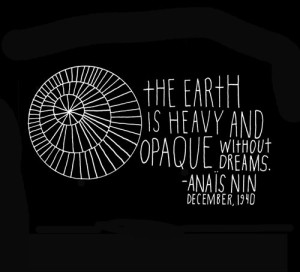How Mind-Wandering and “Positive Constructive Daydreaming” Enhance Creativity and Improve Our Social Skills
INSPIRATIONAL, 14 Oct 2013
Maria Popova, Brain Pickings – TRANSCEND Media Service
The science of why fantasy and imaginative escapism are essential elements of a satisfying mental life.
Freud asserted that daydreaming is essential to creative writing — something a number of famous creators and theorists intuited in asserting that unconscious processing is essential to how creativity works, from T. S. Eliot’s notion of “idea incubation” to Alexander Graham Bell’s “unconscious cerebration” to Lewis Carroll’s “mental mastication.” In the 1950s, Yale psychologist Jerome L. Singer put these intuitive observations to the empirical test as he embarked upon a groundbreaking series of research into daydreaming. His findings, eventually published in the 1975 bible The Inner World of Daydreaming (public library), laid the foundations of our modern understanding of creativity’s subconscious underbelly. Singer described three core styles of daydreaming: positive constructive daydreaming, a process fairly free of psychological conflict, in which playful, vivid, wishful imagery drives creative thought; guilty-dysphoric daydreaming, driven by a combination of ambitiousness, anguishing fantasies of heroism, failure, and aggression, and obsessive reliving of trauma, a mode particularly correlated with PTSD; and poor attentional control, typical of the anxious, the distractible, and those having difficulties concentrating.
In a recent paper titled “Ode to Positive Constructive Daydreaming” (PDF), published in the journal Frontiers in Psychology, writer Rebecca McMillan and NYU cognitive psychologist Scott Kaufman, author of Ungifted: Intelligence Redefined, revisit Singer’s work to deliver new insights into how the first style of Singer’s mind-wandering, rather than robbing us of happiness, plays an essential, empowering role in daily life and creativity.
One of the most fascinating aspects the authors explore is the seeming paradox of the high costs of daydreaming, which prevents us from wholly inhabiting the present moment, and the astounding frequency with which we engage in it. This is related to the default mode network (DMN), which neuroscientists discovered in the late 1990s and which Singer presaged by decades — a neural network that engages when our brain is at wakeful rest, as in meditation, rather than actively focused on the outside world. The authors explain:
While the costs of mind wandering are apparent and easily quantifiable, the benefits seem less obvious and tangible. They require us to dig a bit deeper.
Singer and colleagues report many of the costs associated with mind wandering, yet the central theme of Singer’s large body of work is the manifestly positive, adaptive role that daydreaming plays in our daily lives. We turn now to the benefits of daydreaming first described by Singer, then bolstered by recent studies exploring the adaptive role of the DMN and mind wandering on cognition.
Right from the start, Singer’s research produced evidence suggesting that daydreaming, imagination, and fantasy are essential elements of a healthy, satisfying mental life. His early research included studies looking at delayed gratification and the interaction of imagination and waiting ability in young children. In another early study presented evidence of correlation between daydreaming frequency, measures of creativity, and storytelling activity. … Singer explored the relationship between daydreaming, personality, divergent thought, creativity, planning, problem solving, associational fluency, curiosity, attention, and distractibility. Singer noted that daydreaming can reinforce and enhance social skills, offer relief from boredom, provide opportunities for rehearsal and constructive planning, and provide an ongoing source of pleasure. In later work, Singer describes those who engage in positive constructive daydreaming as “happy daydreamers” who enjoy fantasy, vivid imagery, the use of daydreaming for future planning, and possess abundant interpersonal curiosity.
Pointing to recent research, McMillan and Kaufman argue that Singer presaged the same four primary adaptive functions of positive constructive daydreaming that modern neuroscience has identified since the discovery of the DMN:
Future planning which is increased by a period of self-reflection and attenuated by an unhappy mood; creativity, especially creative incubation and problem solving; attentional cycling which allows individuals to rotate through different information streams to advance personally meaningful and external goals; and dishabituation which enhances learning by providing short breaks from external tasks, thereby achieving distributed rather than massed practice. All four functions are present in Singer’s work, though his terminology differs.

Lynda Barry watercolor over Freud’s essay on creative writing and daydreaming. Click image for details.
The authors debunk yet another paradox in the study of daydreaming — the notion that mind-wandering is often bemoaned as a “mental mishap” or “cognitive failure,” yet it can also be, and often is, an act of volition:
Individuals can choose to disengage from external tasks, decoupling attention, in order to pursue an internal stream of thought that they expect to pay off in some way. The pay off may be immediate, coming in the form of pleasing reverie, insight, or new synthesis of material, or it may be more distant as in rehearsing upcoming scenarios or projecting oneself forward in time to a desired outcome. Projection backward in time to reinterpret past experiences in light of new information is also a possibility. All of these activities, which take place internally, sheltered from the demands of external tasks and perception, offer the possibility of enormous personal reward. These mental activities are, in fact, central to the task of meaning making, of developing and maintaining an understanding of oneself in the world. … Certainly a large share of mind wandering occurs without permission or awareness. But some mind wandering occurs because we actively choose to decouple from external tasks and perceptions and focus instead on an internal stream of thought with full awareness both of the choice being made and the contents of consciousness.
[…]
It seems likely that the ability to engage in volitional daydreaming, i.e., to switch easily back and forth between different streams of consciousness, might be sensitive to practice effects. Choosing to disengage from external tasks, decouple, turn attention inward, and follow an internal stream of thought with full awareness undoubtedly requires skill. The process can break down in a number of places along the way: at the decision point, decoupling, the switch from outer to inner streams of consciousness, or meta-awareness. But the more a person does it, the easier it is likely to become.
They cite Singer himself, who noted this cognitive dance:
Our human condition is such that we are forever in the situation of deciding how much attention to give to self-generated thought and how much to information from the external social or physical environment.
Though McMillan and Kaufman’s conception of mind-wandering does border on romantic idealism at times — there are, after all, some hard numbers on the matter — it does give one pause about the art of pausing and offers a necessary antidote to our cultural cult of extreme goal-oriented productivity:
We mind wander, by choice or accident, because it produces tangible reward when measured against goals and aspirations that are personally meaningful. Having to reread a line of text three times because our attention has drifted away matters very little if that attention shift has allowed us to access a key insight, a precious memory or make sense of a troubling event. Pausing to reflect in the middle of telling a story is inconsequential if that pause allows us to retrieve a distant memory that makes the story more evocative and compelling. Losing a couple of minutes because we drove past our off ramp, is a minor inconvenience if the attention lapse allowed us finally to understand why the boss was so upset by something we said in last week’s meeting. Arriving home from the store without the eggs that necessitated the trip is a mere annoyance when weighed against coming to a decision to ask for a raise, leave a job, or go back to school.
And yet, there’s something to be said for bridging these adaptive benefits of mind-wandering with an active intention to remain awake to the world before us — because, as Annie Dillard poignantly observed, “how we spend our days is, of course, how we spend our lives,” and while spending some of those in daydreams might be delicious, the art of living, unlike the art of writing, is more than a guided dream.
The article, which you can read in PDF here, concludes by reminding us just how far ahead of his time Singer was, and how seminal his theories were for modern cognitive science:
Whatever aspect of mind wandering current researchers might wish to pursue, it is likely that Singer considered the question first and made as thorough an investigation as the technology of the day would allow. His research serves as a solid foundation and springboard for all who come after him and share his fascination with positive constructive daydreaming, mind wandering, and the imaginative capabilities of the human mind.
A used copy of Singer’s The Inner World of Daydreaming — sadly, long relegated to the lamentable cemetery of out-of-print gems — is very much worth the hunt. Complement it with this omnibus of cultural icons on what creativity is.
___________________________
Brain Pickings is the brain child of Maria Popova, an interestingness hunter-gatherer and curious mind at large obsessed with combinatorial creativity who also writes for Wired UK and The Atlantic, among others, and is an MIT Futures of Entertainment Fellow. She has gotten occasional help from a handful of guest contributors.
Go to Original – brainpickings.org
DISCLAIMER: The statements, views and opinions expressed in pieces republished here are solely those of the authors and do not necessarily represent those of TMS. In accordance with title 17 U.S.C. section 107, this material is distributed without profit to those who have expressed a prior interest in receiving the included information for research and educational purposes. TMS has no affiliation whatsoever with the originator of this article nor is TMS endorsed or sponsored by the originator. “GO TO ORIGINAL” links are provided as a convenience to our readers and allow for verification of authenticity. However, as originating pages are often updated by their originating host sites, the versions posted may not match the versions our readers view when clicking the “GO TO ORIGINAL” links. This site contains copyrighted material the use of which has not always been specifically authorized by the copyright owner. We are making such material available in our efforts to advance understanding of environmental, political, human rights, economic, democracy, scientific, and social justice issues, etc. We believe this constitutes a ‘fair use’ of any such copyrighted material as provided for in section 107 of the US Copyright Law. In accordance with Title 17 U.S.C. Section 107, the material on this site is distributed without profit to those who have expressed a prior interest in receiving the included information for research and educational purposes. For more information go to: http://www.law.cornell.edu/uscode/17/107.shtml. If you wish to use copyrighted material from this site for purposes of your own that go beyond ‘fair use’, you must obtain permission from the copyright owner.
